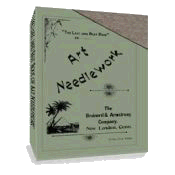[]Subscribe To This Site
Tiger Lily and Japan Lily
Using Raised Embroidery
The Tiger Lily and Japan Lily lend themselves to raised effects admirably, and are easily made. First, stamp the design on the material to be embroidered – that is the leaves and foliage – be careful, however, not to stamp the flower itself, as its position will be sufficiently indicated by the stems, and if the flower were stamped it would be difficult to cover the marks.

Click on picture to see more detail.
The figure above shows the correct shape by which to cut the wire petals for a tiger lily. It should be drawn from the figure and cut out of stiff cardboard so as to secure a pattern by which to cut the wire. For a Japan lily, this pattern should be cut three times as large.
Materials required for a single Japan or Tiger Lily are as follows: Screen wire, finest mesh, blond net, arrasene and chenille. Both varieties of lilies are worked in the same manner, so that the instructions for one will answer for the other.
Three shades of orange yellow arrasene will be required for working the petals of the tiger lily, and one shade of pinkish white arrasene for the petals of the Japan lily. The brown spots marking the petals of both varieties should be imitated with reddish brown chenille, – the finest made – with seed stitch.
The centers of the flowers can be purchased at any art store, though they may be very successfully made at home by grouping together pieces of fine hair wire for stamens. Cut the wires about three inches long and bind them firmly together at the bottom; spread the wires apart at the top and fasten on the point of each a tiny bit of cotton wool; dip the whole in melted rosin, and then, while still wet, dip the very points covered with the wool in dry mustard, or sprinkle with gold powder.
For a Tiger Lily cut six petals out of the wire, by the pattern previously prepared, and cover them with the blond net. Work as follows: Begin at the tip of the wire petal with the lightest shade of the orange yellow, and work it downward in Kensington stitch to the base, using the three shades of orange yellow – the darkest at the base of petal. Work both sides of the wire petals alike. When finished group them around the prepared center and secure with a few invisible stitches. After the stems and foliage have been worked with arrasene or chenille, punch a small hole at the point where the flower is to be placed and insert the stem of the lily, fastening it on the back of the material, and also catch a stitch or two lightly through the petals that lie next the material; curl the points of the petals outward, and work a few stitches on the lower part of flower with olive green chenille, to form the calyx. The Japan lily is made and placed in position in exactly the same manner.

Click on picture to see more detail.
Groups of either Japan or Tiger Lilies made in the above manner are suitable ornaments for the tops of toilet cushions, banners or plaques. To make one lily of either variety will require three skeins of arrasene, one skein of olive green chenille for the calyx, one thread brown chenille for the markings of petals, one yard hair wire and one-half foot of screen wire. Multiply the above quantity by the number of flowers on a pattern and it will give the necessary amount of material for that pattern. The background should bee satin or velvet, either cream, blue or deep moss green.
Return to top of Tiger Lily and Japan Lily page.
Return to Types of Embroidery page.
Return to Special Designs page.
Return to Home page.



 433 pages!
433 pages!

